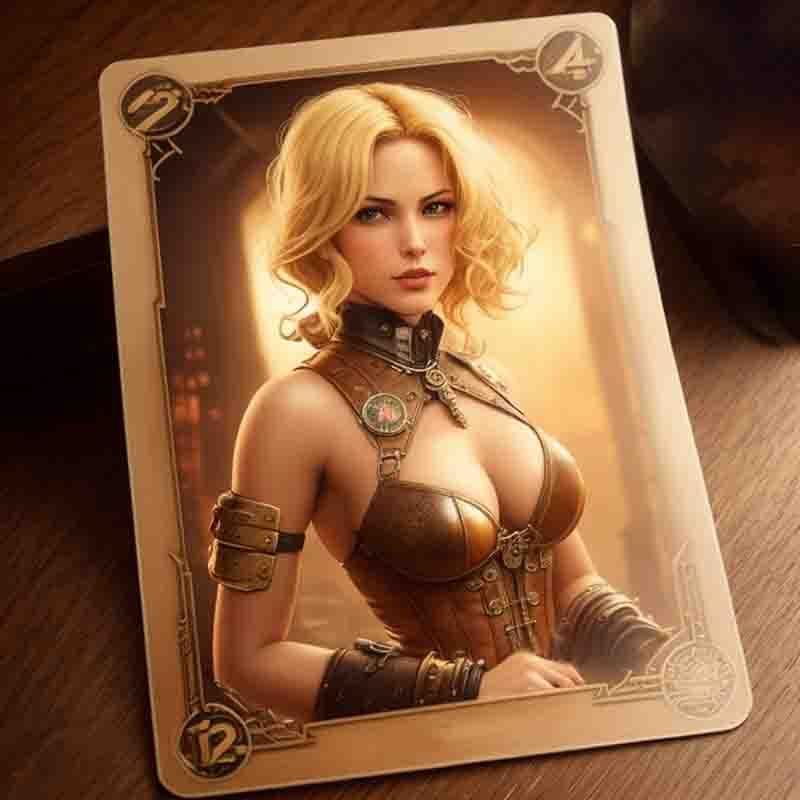A Comprehensive Guide to Trading Cards Collecting
Trading cards are collectible items, typically rectangular in shape and made of either physical or digital materials, featuring diverse themes such as sports, gaming, entertainment franchises, or historical events.

Trading cards encompass a broad spectrum of collectibles that have transitioned from physical to digital formats, with NFTs and blockchain technology reshaping the landscape.
Trading cards have a rich history, initially gaining popularity in the sports industry.
As the concept expanded, trading cards began to cover a wide array of topics, including fantasy games, movies, TV shows, and even historical events.
The physical versions are often traded, bought, and sold among collectors, with certain rare or limited editions holding considerable monetary value.
In recent years, the rise of digital trading cards has been notable, especially with the advent of blockchain technology.
Digital trading cards are often associated with NFTs, unique cryptographic tokens that verify the ownership and authenticity of a specific digital item.
NFTs (non-fungible tokens) enable secure and transparent transactions on blockchain platforms, allowing collectors to buy, sell, and trade digital cards with confidence.
Trading cards are considered collectibles, valued for their rarity, historical significance, or aesthetic appeal. The shift to digital formats, NFTs, has given rise to digital trading cards, which exist as digital assets.
Trading Cards Timeline
Traditional trading cards have a storied history, often associated with sports, entertainment franchises, and pop culture.
From the beloved baseball cards of yesteryears to contemporary sets featuring movies, TV shows, and historical events, these tangible collectibles hold sentimental value for enthusiasts.
Collectible cards often feature characters and elements from popular video games in 8-bit graphics, comics and graphic novels associated with the cyber punk genre, leading to a crossover between game culture and collectible enthusiasts.
The design of trading cards often mirrors contemporary art movements. From the vibrant and abstract designs of the 1960s to the minimalist and digital aesthetics of the 21st century, trading cards encapsulate the artistic zeitgeist of their respective eras.
| Time Period | Key Events |
|---|---|
| 1862 | The origin of trading cards can be traced back to 1862 when tobacco companies began inserting cards into their product packaging to stiffen the packaging and promote their brands. |
| 1886 | The late 19th century saw the emergence of baseball cards as a popular collectible. Allen & Ginter's baseball cards, produced in 1886, gained immense popularity, marking the start of trading cards becoming associated with sports. |
| 1900s | The early 1900s witnessed the Golden Age of Trading Cards, marked by the proliferation of themes beyond sports. Trading cards began featuring a wide array of subjects, including movie stars, historical events, and wildlife. |
| 1952 | The release of Topps' 1952 baseball card set, featuring the iconic Mickey Mantle card, is considered a landmark moment in trading card history. The set is highly coveted among collectors. |
| 1970s | The 1970s saw trading cards diversify further, expanding beyond sports to include themes from popular culture, entertainment, and television shows. |
| 1980s | The 1980s marked a boom in the collectibles market, with trading cards playing a significant role. Increased production led to a wide variety of card sets, catering to diverse interests. |
| 1990s | The 1990s brought innovation to trading cards with the introduction of holographic and premium cards. These cards featured special effects, foil stamps, and unique designs, captivating collectors. |
| 2000s | With the advent of the internet, the 2000s witnessed a transition to digital trading cards. Online platforms allowed collectors to engage in virtual trading, expanding the reach of Trading Card Collectors. |
| 2009 | In 2008, blockchain technology was introduced and paved a new way to authenticate and verify ownership of physical and digital trading cards. |
| 2014 | The 2010s marked a pivotal moment with the rise of Non-Fungible Tokens (NFTs), leveraging blockchain for digital trading cards. NFTs provided a unique way to establish ownership and authenticity in the digital realm. |
| 2020s | The 2020s have seen the continued growth of NFT trading cards, with an expansion into diverse themes beyond traditional genres. The intersection of blockchain technology and creative themes continues to shape the trading card landscape. |
This timeline highlights key milestones in the history of trading cards, from their inception in the 19th century to the digital revolution and emergence of NFTs in the 21st century.
Every Trading Card Tells a Tale

Within the captivating world of trading cards, rarity stands as a beacon of desirability, enticing collectors with the allure of exclusivity.
Trading Cards 101: A Beginner's Primer
Trading cards, at their core, are portable canvases that encapsulate moments of history, art, and culture.
Originating from the Victorian era as promotional tools for businesses, these cards gradually transformed into collectibles with a wide range of themes.
Whether featuring sports stars, fictional characters, or iconic moments, trading cards cater to diverse interests, fostering vibrant communities of collectors.
Each category, be it sports cards capturing athletic prowess or gaming cards immersing enthusiasts in fantastical realms, offers a unique entry point for collectors, making the world of trading cards rich and varied.
The Artistry Behind Trading Cards: Design and Aesthetics
The allure of trading cards extends beyond their content to the captivating designs that adorn them.
The evolution of trading card aesthetics mirrors the broader trends in art movements.
From the delicate illustrations of the early 20th century to the bold, dynamic designs influenced by modern graphic design, these miniature canvases embody the artistic trends of their respective eras.
Technological advancements have further revolutionized trading card designs, with augmented reality (AR) and digital elements seamlessly integrated, creating an immersive and visually stunning collecting experience.
A Deep Dive into Trading Card Themes

Whether exploring historical figures, cultural phenomena, or literary masterpieces, these cards become portals to different dimensions of human knowledge and creativity.
Themes embedded in trading cards act as cultural touchstones, reflecting and influencing societal conversations.
Whether addressing diversity and inclusivity or tapping into nostalgic sentiments, trading cards encapsulate the spirit of their times.
The industry's exploration of entertainment themes, featuring beloved characters from movies, TV shows, and video games, highlights the interconnectedness of various pop culture realms.
Furthermore, the resurgence of nostalgia in trading card themes, revisiting and reimagining classic designs, resonates with collectors of all ages, creating a bridge between the past and the present.
The Influence of Limited Editions: Rarity and Exclusivity
Limited editions in the world of trading cards serve as more than collectibles; they become coveted status symbols within the collector's community.
The scarcity and exclusivity associated with limited editions drive collector interest, turning these cards into sought-after treasures.
The parallel between limited editions in trading cards and the sneaker culture is unmistakable.
Both realms thrive on the allure of exclusivity, creating a sense of urgency and desire among collectors.
The careful curation of limited editions transforms trading cards into not just commodities but symbols of exclusivity and prestige.
Collectibles Market Dynamics: Speculation and Trends

In the digital age, the world of trading cards has expanded beyond local shops and conventions, with a vast online marketplace waiting to be explored.
The trading card market operates in a realm where speculation and trends intertwine, shaping the value and desirability of cards.
The speculative nature of the market is evident as collectors anticipate the next big trend or the emergence of a viral moment.
Ephemeral trends and meme culture have found a niche within trading cards, capturing cultural snapshots and translating them into valuable and sought-after collectibles.
The market dynamics, influenced by hype and ever-changing trends, create a dynamic and evolving landscape that keeps collectors on the edge of their seats.
The Social Aspect: Communities, Events, and Fandom
Trading cards transcend the realm of mere collectibles; they are social catalysts fostering communities and shared passions.
Online communities dedicated to trading cards have proliferated, providing spaces where enthusiasts connect, share insights, and build relationships.
Conventions and events dedicated to trading cards serve as physical manifestations of this communal spirit, where collectors gather to celebrate their shared love for these small but meaningful artifacts.
The social aspect of trading card collecting adds a layer of depth to the hobby, transforming it into a shared experience that transcends individual collections.
Beyond Traditional Boundaries: Trading Cards in the Digital Realm

Digital trading cards showcase a new dimension of creativity. Artists leverage pixel art and high-definition graphics to create immersive and visually stunning collectibles.
The integration of technology into trading cards marks a paradigm shift in the collecting experience.
Blockchain technology ensures authenticity, security, and transparent ownership, addressing concerns related to counterfeiting and provenance.
Digital augmentation, including augmented reality and other digital components, enhances the overall collecting journey.
Collectors can now experience additional layers of content, animations, and interactivity, bridging the gap between the physical and digital realms.
This intersection of traditional collecting and cutting-edge technology represents the future trajectory of trading cards.
Sustainability in Trading Cards: Eco-Friendly Practices
As the world becomes more conscious of environmental issues, the trading card industry is embracing sustainability.
Eco-friendly packaging and production methods are becoming standard practices, responding to the growing demand for responsible consumption.
Initiatives promoting recycling and circular economy principles within the trading card industry further highlight the commitment to environmental consciousness.
Collectors are increasingly aligning their passion for trading cards with sustainable practices, contributing to a more eco-friendly future for the hobby.
The Future Landscape of Trading Cards: Speculations and Trends

The origin of trading cards can be traced back to the 1860s when tobacco companies began inserting cards into their product packaging to stiffen the packaging and promote their brands.
The future of trading cards holds exciting possibilities shaped by technological advancements, changing consumer preferences, and broader societal shifts.
Speculations regarding the role of technology, including blockchain advancements and innovative digital features, hint at a more dynamic and interconnected collecting experience.
The evolving preferences of collectors, influenced by sustainability and cultural trends, will continue to shape the market.
The intersection of technology, sustainability, and cultural shifts paints a fascinating picture of the future landscape of trading card collecting, where innovation and tradition coexist.
The Ever-Evolving Subject Matter of Collecting Trading Cards
Collectible cards are not just collector's items, but artifacts that reflect the dynamic interplay of history, art, culture and technology.
The resurgence of interest in trading cards signifies a cultural shift where these small canvases have become gateways to diverse realms of passion and nostalgia.
From their humble origins to the integration of cutting-edge technology, trading cards continue to evolve, creating a dynamic and ever-unfolding narrative that captivates collectors worldwide.
As enthusiasts explore the multifaceted world of trading card collecting, they contribute to a narrative that goes beyond individual collections, forming a shared tapestry that mirrors the spirit of their times.
A Guide to Valuable Trading Cards

The expansive world of collectible cards extends far beyond sports, offering enthusiasts a journey through cinematic wonders, historical narratives, and cultural expressions.
Navigating the realm of trading cards as an investment requires a keen eye, strategic thinking, and an understanding of the factors that contribute to a card's potential value.
Whether you're a seasoned collector or a newcomer to the world of trading cards, consider the following guide to identify cards with investment potential.
-
Professional Grading: Cards graded by reputable grading services provide an objective assessment of their condition, authenticity, and overall quality.
-
Eventful Moments: Cards associated with historical events, record-breaking achievements, or cultural milestones carry intrinsic value.
-
Rookie Cards: Rookie cards mark a player's debut in the trading card market and are often highly sought after by collectors.
-
Athlete's Legacy: Players recognized with Hall of Fame inductions often see increased demand for their cards.
-
Cultural Icons: Cards featuring beloved characters, cultural icons, or franchises with a dedicated fan base hold enduring appeal.
-
Current Market Dynamics: Stay informed about current trends, collector sentiments, and market dynamics to anticipate shifts in demand.
-
Collaborative Releases: Cards resulting from collaborations between trading card companies, artists, or brands may carry unique appeal.
-
Storage and Handling: Ensure cards are stored in protective sleeves or cases to maintain their quality over time, enhancing their investment potential.
-
Collector Communities: Active engagement with collector communities provides insights into emerging trends, potential sleeper cards, and market sentiment.
By blending a strategic mindset with a passion for the hobby, investors can navigate the diverse landscape of trading cards and uncover hidden gems with the potential for long-term value appreciation.
Guardians of Legitimacy: Unveiling Authentication Methods for Trading Cards
In the dynamic world of trading cards, where authenticity is paramount, robust authentication methods serve as the guardians of legitimacy.
From traditional grading services to cutting-edge blockchain technology, each method contributes to the overarching goal of ensuring the legitimacy of trading cards in the market.
-
Professional Grading Services: Professional grading services are the bedrock of trading card authentication. Reputable organizations, such as PSA (Professional Sports Authenticator), Beckett, and SGC (Sportscard Guaranty), evaluate cards based on their condition, authenticity, and overall quality.
-
Hologram Stickers and Seals: A unique holographic image or seal is affixed to the card, typically on the packaging or the card itself. These holograms are challenging to replicate due to their intricate designs.
-
Watermarks and Embedded Features: Manufacturers include subtle watermarks, microprinting, or embedded security features that are difficult to reproduce. These features are often visible under magnification.
-
Serial Numbers: Serial numbers provide a clear and individualized identifier for each card, enabling collectors to track a card's origin and authenticity.
-
Authentication Certificates: Authentication certificates offer a paper trail of the card's legitimacy, providing collectors with tangible proof from a recognized authority.
-
UV Technology: UV technology adds an extra layer of security, as counterfeiters may not be aware of or able to replicate the UV elements.
-
Blockchain and NFTs: Cards can be tokenized as NFTs on a blockchain, creating a unique digital identifier for each card. Ownership and transaction history are securely recorded on the blockchain.
-
Microchip Technology: The microchip may store information about the card, such as its origin, production details, or authenticity features. Collectors can use compatible devices to read the embedded data.
-
Third-Party Authentication Services: Third-party authentication services offer an additional layer of scrutiny, providing collectors with peace of mind through external verification.
-
Educational Resources for Collectors: Educational materials, online guides, and forums provide information on recognizing authentic cards, detecting common counterfeiting methods, and staying updated on evolving authentication technologies.
Collectors, armed with knowledge about these authentication techniques, can confidently engage in the vibrant world of trading cards, knowing that their prized collectibles are not only treasures but also authenticated guardians of the hobby's integrity.
Companies That Produce and Sell Trading Cards
Trading cards, beyond their inherent collectible and monetary value, often possess a unique ability to transport individuals back in time, triggering waves of nostalgia and fond recollections of childhood.
These small pieces of cardboard, adorned with images of sports heroes, beloved characters, or cultural icons, become more than mere collectibles—they become cherished vessels of sentimental value.
-
Topps: A leading producer of sports trading cards, entertainment cards, and collectibles.
-
Panini: Renowned for sports trading cards, including basketball, football, and soccer.
-
Upper Deck: Known for high-quality sports trading cards, gaming cards, and entertainment collectibles.
-
Cryptozoic Entertainment: Produces trading cards, tabletop games, and collectibles, including popular entertainment franchises.
-
Wizards of the Coast: Creator of trading card games like Magic: The Gathering and Pokémon Trading Card Game.
-
Leaf Trading Cards: Specializes in producing trading cards across various sports and entertainment categories.
-
Benchwarmer: Focuses on producing trading cards featuring collectible cards of female models and celebrities.
-
CryptoKaiju: Merges physical collectibles with blockchain technology, creating limited edition NFT trading cards
-
Marvel Entertainment: Releases trading cards featuring popular Marvel superheroes and characters.
-
Konami: Publisher of trading card games, including the Yu-Gi-Oh! Trading Card Game.
Please note that the availability of trading cards from these companies may vary based on geographical location and specific product releases. Always check the official websites or authorized distributors for the latest offerings.
Unlocking Rarity: The Intricate Dance of Factors in Trading Card Desirability
Within the captivating world of trading cards, rarity stands as a beacon of desirability, enticing collectors with the allure of exclusivity.
The rarity of trading cards is a delicate dance of intentional limitations, unforeseen variations, and the cultural fabric created by players, moments, and historical significance.
Collectors navigate this intricate landscape, seeking not just cards but the stories and exclusivity that make each piece a coveted treasure.
This exploration delves into the nuanced factors that make certain trading cards rare and, consequently, highly sought after.
-
Scarce Production: The most straightforward contributor to rarity is a limited print run. Cards produced in smaller quantities during their initial printing become scarce, capturing the attention of collectors seeking exclusivity.
-
Anniversary Editions and Special Releases: Special editions, anniversary releases, or commemorative sets often feature limited print runs, adding a layer of exclusivity to these cards.
-
Diverse Offerings: Trading card sets often include various inserts, parallel sets, and card variations. Certain inserts or parallel sets are intentionally produced in smaller quantities, making them rarer than the base cards.
-
Short Prints: Short prints, which are variations of specific cards intentionally printed in lower numbers, contribute significantly to rarity. Collectors avidly seek these elusive short prints to complete their sets.
-
Signed Exclusivity: Cards featuring player autographs or pieces of game-worn memorabilia inherently possess rarity due to the personalized nature of these additions. Autographed cards, especially those from limited signing sessions, carry heightened desirability.
-
Limited Edition Memorabilia: Relic cards, embedding fragments of jerseys, bats, or other memorabilia, are produced in limited quantities, elevating their rarity. The uniqueness of each relic adds an extra layer of exclusivity.
-
Quantifiable Rarity: Serial numbering, assigning a unique number to each card in a limited set, provides a quantifiable measure of rarity. Collectors often seek lower-numbered cards, such as those with single or double-digit serial numbers, for their increased exclusivity.
-
Serial Number Hierarchy: Understanding the hierarchy of serial numbers within a set allows collectors to discern the relative rarity of individual cards, further influencing their desirability.
-
Unintended Rarity: Error cards, resulting from printing mistakes or misprints, add unintended rarity to certain cards. Collectors often find these cards particularly intriguing due to their unexpected scarcity.
-
Promise of Future Rarity: Redemption cards, which promise collectors a future card once redeemed with the manufacturer, contribute to rarity by limiting the immediate availability of certain cards. The anticipation of receiving the card adds to its desirability.
-
Limited Redemption Periods: Manufacturers often impose time constraints on redemption periods, creating a sense of urgency among collectors to claim their cards within a specified timeframe.
-
Preserving Rarity: The grading and authentication process, performed by reputable services like PSA or Beckett, reinforces the rarity of certain cards. Graded cards often command higher values due to the assurance of their condition and authenticity.
-
Higher Grades, Greater Rarity: Cards graded with higher scores become scarcer within the graded population, further contributing to their rarity and desirability.
Understanding the factors that contribute to rarity enhances the joy of the hunt, transforming trading cards into not just collectibles, but artifacts of unique and sought-after rarity within the vibrant world of sports and entertainment collecting.
The Thrill of Collecting Trading Cards
Trading cards, once relegated to the realm of childhood pastimes, have emerged from obscurity to captivate a new generation of collectors.
The history of trading cards is a fascinating journey, evolving from simple cardboard pieces exchanged by enthusiasts to a diverse array of collectibles spanning sports, gaming, entertainment, and more.
The resurgence of interest in trading cards in recent years signifies a cultural shift, where these small canvases have become prized artifacts reflecting the spirit of their times.
Trading Cards: FAQ
Are you curious about music, art, technology, fashion, lifestyle, and beer?
If so, then you need to subscribe to the free Likewolf newsletter.
100% privacy. When you sign up, we'll keep you posted.
Medium for Storytelling
Digital Art in the Modern World
